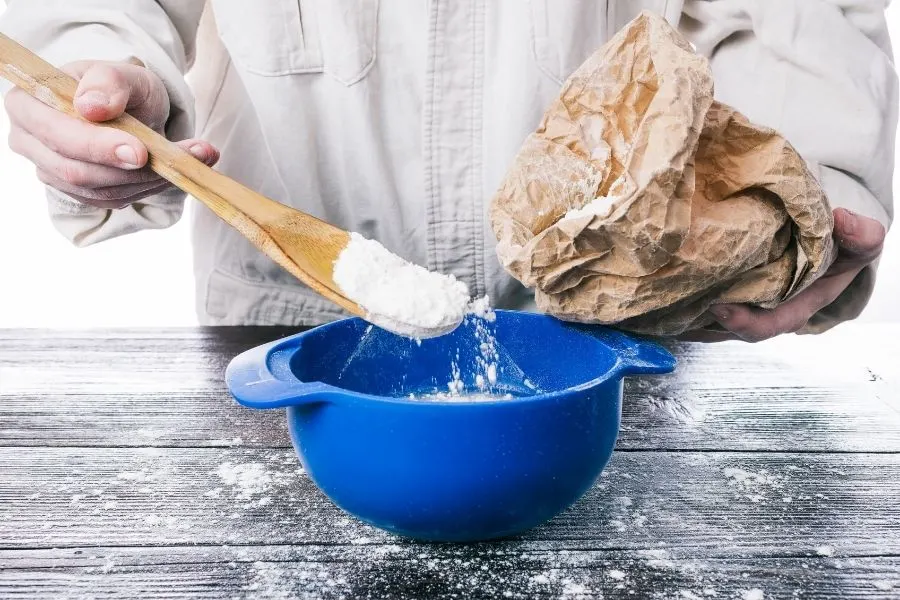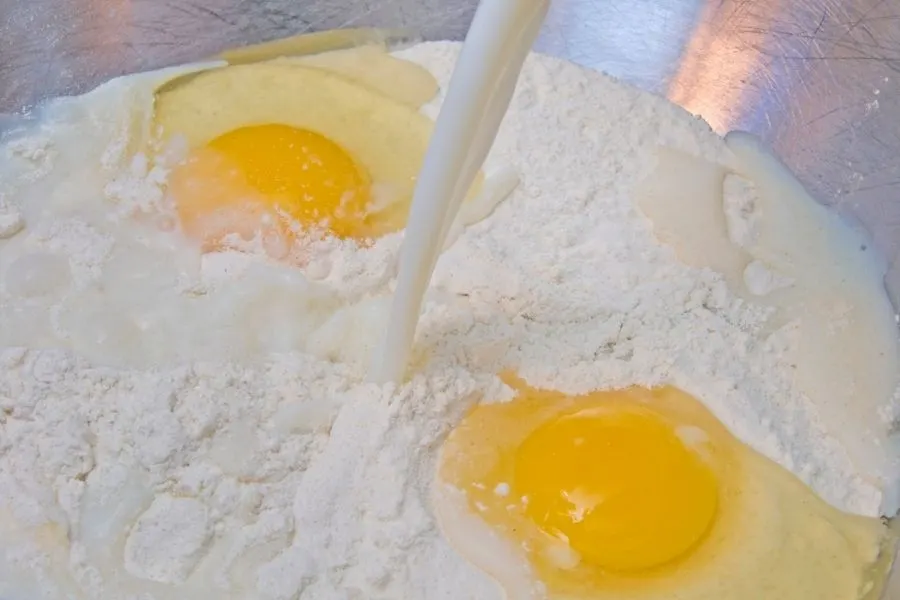Pancakes are such a delicious breakfast staple but they’re a real pain to get right every time. Even if you measure your ingredients, sometimes you get the recipe a little wrong and then you have to add and combine until you get way too much batter. That’s okay, you can always freeze them for later.
But what if your pancakes come out dry as a desert ? You’re trying to thicken that stubborn batter and now you’ve got something to slap a fly on the wall. Why does this happen ? Can this be fixed ? How can you avoid it in the future ?

Why are my pancakes dry ?
Dry pancakes are a direct result of too much flour, too little egg or butter, and too little leavening agent. The pancake batter needs the gluten in the flour to trap the rising air, formed by the leavening agent. The proteins in eggs help keep the gluten network stable, while the butter and yolk add moisture.
When the wet ingredients are too few you get a dry pancake, and if you do not add enough leavening agent like baking soda or powder, you get a dense, dry pancake.
If your pancakes end up dry, you can always serve them with something extra moist, like lightly whipped heavy cream, chocolate syrup, a runny jam, maple syrup, etc.
Now let’s take a closer look at all these factors so you get the perfect pancakes.
1. Too much flour
When the pancake batter has too little flour it will be very loose. When there is too much flour it will not spread as much in the pan, but it will also cook a bit slower.

The problem with adding too much flour is that you dry out the batter, which further dries when exposed to the heat of the pan. As the baking soda or powder creates air bubbles, the gluten network traps it within the pancake. But too much gluten – from too much flour or overmixing – will result in a chewy, dry pancake.
Read also: Can You Reheat Pancakes ?
To fix this, add a bit of melted butter into your pancake mix. If you add a whole extra egg you make it too loose, and you also have to beat it into the batter. This results in overmixing, so again more gluten.
For pancakes made with oats or similar cereal flakes, the pancakes come out dry because the oats are dry to begin with. They will absorb whatever moisture is in the batter, and still be drier than you’d like. To fix this use pre-soaked oats.
2. Too much baking powder or soda
If you’re afraid of flat, dense pancakes you’re likely to add some extra baking soda or powder. This will definitely help the cake rise, but it can go too far to the point where you have too many air bubbles, rising too fast. This can dry out the batter and make it really brittle. Not to mention with an off flavor.
To fix this add in a bit of flour, stir, and let sit for a couple of minutes.
3. Too little egg or butter
You may not want to add too much egg into the pancake mix for fear of it turning into an omelette. And that’s fair, an egg is enough, two eggs can be fine as long as you’re making breakfast for everyone.
If you’ve already added an egg and it’s still a thick, dry batter consider adding some melted butter. Oil will work too, but it behaves a little differently than butter. It’s also easier to control how much butter you add, as you can decide the quantity. Eggs come with their own sizes.

Tips on getting the perfect pancakes
The perfect pancake is an art, since it will always have a slight difference from batch to batch. However there are a few things you should always do, or be aware of when you’re trying for the best pancake. Or at least decent, not-burned, and hopefully not-dry pancakes. These things take a lot of practice !
Use medium heat for an even cooking
No matter what kind of recipe you’re using you first need to get the heat to medium, and keep it that way. Always use a non-stick pan and always add just a bit of butter or a drop of cooking oil. You don’t need a layer of fat there, just enough to lightly coat the pan.
Medium heat means even cooking on all sides. If you use low heat, you risk the pancake sticking, and also waiting until tomorrow for the bubbles to come on top. If you use high heat you get burnt undersides by the time they’re ready to flip. And if you do flip them before you get those awful splattered pancakes no one wants.
Use a leavening agent to get rising
You need a bit of help to make the pancakes rise, don’t kid yourself. The eggs help the gluten stabilize, but they have to work with something to create all those air bubbles. Whether you use baking powder or soda is up to you, both work fine. But add at least half a teaspoon to make sure you get some action going.
Otherwise you get those dense, thick pancakes.
Mix in some melted butter for flavor and smoothness
To ensure everything runs smoothly melt a bit of butter and mix it into the batter. It will bind right into the egg and combine really well with the flour, don’t worry. It’s the extra moisture from the butter that helps lubricate the entire pancake and it helps it not stick !
Let the batter rest for 10 minutes
Another tip is to let the batter sit for a few minutes, and maybe add your leavening agent afterwards. This is useful if you’ve overmixed the batter and developed the gluten. As the batter sits the gluten relaxes, and the wheat particles get a chance to absorb more moisture. It’s kind of like leaving oats overnight, they draw the moisture they need.
Letting the batter sit will also ensure a less dry result, with less chance of chalky pancakes. So everyone wins here.
Read Also: Pancakes VS Waffles
How do I know when to flip the pancake ?
Pancakes are ready to flip when you see bubbles emerging all over the top, about 3 minutes in. The bubbles will start from the edges as those cook first. Then more and more bubbles will appear in the middle of the pancake. The very top should no longer be shiny, it should be a little matte and the edges will likely start to dry out.
This is what you’re looking for. Make sure your spatula is thin and a bit flexible, and fits at least half the pancake’s size. Slide it under the pancake, and flip with your wrist. If you put your whole arm, or even your shoulder into the movement you ruin the shape.
The pancake is 80% done when you flip it anyway, so make sure you don’t leave it on for more than a minute or a minute and a half. Always remember to use medium heat ! Not low, not high. Medium.

